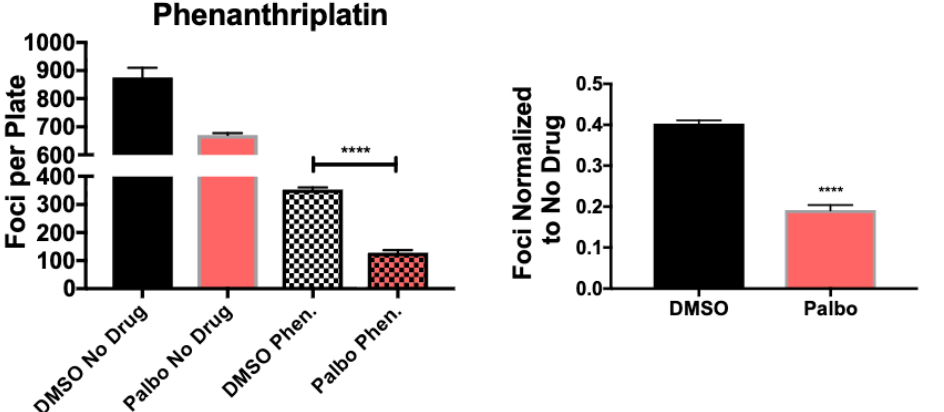What two chemotherapeutic drugs were primarily tested in this study?
Cisplatin and paclitaxel
The drug palbociclib (palbo) was used in many of the figures. What was its role?
palbociclib causes a G1 delay, thus slowing proliferation rates
What overall theory explains why aneuploid cells resist chemotherapy?
Slower proliferation (particularly G1 delays) shields them from drugs that act in specific cell-cycle phases
Why did they use HCT116 cells in addition to MEFs?
HCT116 is a human colon cancer cell line to confirm the mechanism in a human model
What feature of aneuploid cells do the researchers believe leads to drug resistance?
G1 delay / slowed proliferation
What did Figure 1D show about p53’s role in drug resistance?
Resistance to cisplatin in trisomic cells remained when p53 was inactivated, showing the effect is largely p53-independent
Why might combining palbociclib (palbo) with standard chemotherapies be risky for patients?
Palbociclib causes G1 arrest, making cells less sensitive to drugs that target dividing cells.
What secondary analyses did they perform using public datasets and why?
They analyzed the CCLE (Cancer Cell Line Encyclopedia) to correlate aneuploidy, proliferation, and drug response
What mechanism do the researchers use to generate MEFs?
Robertsonian Translocations

In Figure 4C, what TYPE of drug did researchers use that kills cells in G1, and what was the result?
Phenanthriplatin is a Platinum drug like Cisplatin
G1-arrested cells were more sensitive to it, showing phase-specific drug effects
Can euploid cells with G1 delays show chemotherapy resistance?
Yes, the resistance comes from slower proliferation not aneuploidy

In Figure 3, what did the focus formation assay measure?
If there is an increase in survival after G1 delay with chemotherapy treatment
What gap in knowledge were the authors trying to fill?
Whether drug resistance in aneuploid cells arises from specific gene copy changes or from general features of the aneuploid state

What was the main takeaway from Figure 5F?
When aneuploid and euploid cells were slowed to the same growth rate, their resistance to paclitaxel was equal, proving that resistance comes from slow proliferation
How does this study help explain why aneuploidy is linked to poor cancer prognosis even though it slows growth?
Because slow-growing aneuploid cells can better survive chemotherapy cycles, recover, and repopulate the tumor
How could future studies identify specific chromosomes or genes responsible for additional resistance, as seen with Ts16
Perform transcriptomic or CRISPR knockout screens comparing resistant vs. sensitive trisomies
What types of Chemotherapeutics are Cisplatin and Paclitaxel respectively
Alkylating and Plant Alkaloid
 In Figure 6, the CCLE analysis, what relationship did the authors find between aneuploidy, proliferation rate, and drug response?
In Figure 6, the CCLE analysis, what relationship did the authors find between aneuploidy, proliferation rate, and drug response?
High aneuploidy and slow proliferation strongly correlated with resistance to many chemotherapies, especially those targeting cell division
Is chemotherapy resistance phase-specific? If so, how might we use this knowledge to make chemotherapy more effective?
Chemotherapy Resistance is phase-specific.
Ways to make chemo more effective include extending the G1 phase and using chemotherapies that act in G1.
If you were a researcher continuing this project, what one new question would you ask and how would you test it?
Be Creative!